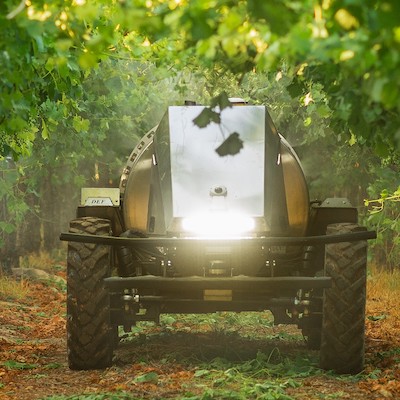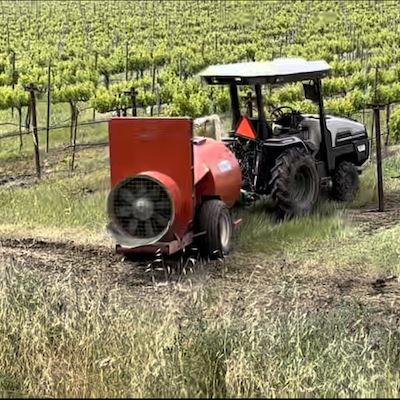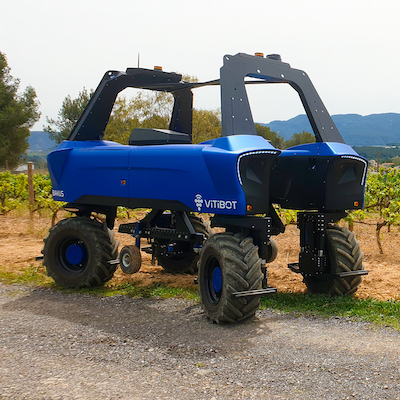- After first being introduced in European vineyards, robotic tractors are being quickly introduced in the United States.
- New manufacturers are emphasizing environment-friendly features such as battery-powered, all-electric machines.
- Costs are incremental while promising productive gains and addressing long-term labor shortages.
- Drones for production usage are facing capacity problems.
For years, Elon Musk, now the world’s richest person, has been promising that fully autonomous, driverless Teslas are idling just around the corner and will be delivered – soon. But grape farmers on California’s West Coast won’t have to wait that long. Before bud break next year, many of them will be accepting delivery of fully autonomous tractors that perform all the farming functions of a conventional farm tractor traditionally driven by a real person.
The use of robots in the vineyard will accelerate a trend that has been occurring in the winegrowing industry since the digital age began merging with the last threads of the Industrial Revolution – but it will not drastically change the business/social interface. Robots, for example, will not be the purview only of major farming corporations, but they will be affordable by moderate-sized wineries who sell to the premium and super premium markets. Anyone who operates conventional tractors and has access to vineyard GPS will be able to use them, and the investment costs will be not be substantially higher. Those who can’t afford them – or don’t want to – will be able to use vineyard service companies who utilize robotic vehicles or perhaps even be able to rent them. Robots will not displace a sizable worker pool, as both skilled and unskilled workers have been in shortage for years in Europe and North America. As far as the environment and sustainability is concerned, the combining of digital and robotic technology will decrease harmful gas emissions and perhaps even make organic grape production available on a larger scale.
At the same time, from a production and quality-control point of view, robots in the vineyard will be a major step forward.
Autonomous Vehicles to Assist in Making Wines
For years, winegrowers worldwide have been using artificial intelligence (AI) and geographic information systems (GIS) to assist them in growing grapes and making wines. Now the promise of combining robotics with those two functions in the form of autonomous vehicles that do everything from weeding to spraying to canopy management of vines is about to be realized. Drones that can spray vines may soon be flying overhead.
“While the adoption of autonomous tractors is not historically as big as the switch was from horses to tractors, we are now on the cusp of a new era in farming,” says Tom Gamble, owner Gamble Family Vineyards in Napa Valley, who farms about 175 acres of vineyards in the region. “And I don’t see it putting anyone out of work, as one person can oversee more than one tractor in operation.” Early this summer, Gamble hosted demonstration programs in his vineyards administered by two California manufacturers of robotic tractors, and he expects to among the first to accept their delivery. Full-size tractors will cost between $60,000 and $70,000 each.
A More Accurate and Sustainable Vineyard Management
The promise of robotic or autonomous machinery that can take advantage of GIS and AI data excites huge promise, with payoffs expected in increased sustainability, more-precise vineyard management, reduced labor needs and costs, less use of diesel and more of electric batteries and even total reduced costs. As Napa County’s 2021 Agricultural Crop Report exults, “Guided by GIS and AI, these robots perform multiple functions, often simultaneously, with the utmost precision.”
“We’ve been following two trials in California,” says Will Drayton, director of technical viticulture, sustainability and research for Treasury Wine Estates, “and we’re ready to pull the trigger in both California and Australia. The economics are there,” Drayton maintains, although he wants to be certain that the support infrastructure for robotic tractors is firmly in place.
From Single Purpose Machines to Fully Electrical Multipurpose Tractors
While the appearance of robots in the vineyards is new to California, it has already had spotty success in Europe, especially in Champagne and other parts of France, where manufacturers have targeted much broader crop categories than solely grape growing. Firms such as VitiBot, Naïo, Yamaha and SITIA all have commercial robots or advanced prototypes of them working in European vineyards. As in the U.S., manufacturers there are taking two different development tracks – single-purpose machines that primarily spray crop-protection chemical or only till versus multipurpose machines that do everything traditional manned tractors can now do.
U.S. developers, however, are making advances in fully electrical, battery-powered tractors that leave virtually no operational carbon footprint. And in one case, an autonomous tractor utilizes existing implements and can even be manually driven if necessary.
Monitored by a Smart Phone
“Our company has a lot of experience in developing AI and self-drive technology,” says Praveen Penmesta, co-founder and CEO of Livermore-based Monarch Tractors.
In fact, one Monarch executive is credited with building out Tesla’s automotive gigafactory, while a Mondavi scion lends the management group winegrowing credentials. As with other self-driven tractors, Monarch’s can be operated and monitored via a smart phone or personal device and receive tractor alerts (it stops and asks for help if there is an unprogrammed impediment), updates on current micro-weather conditions, detailed operations reports, data collection, analysis and storage, all part of the GIS/AI network.
Batteries Remain Expensive
Drayton ticks off some of the advantages of automated tractors: “I think robotics will unlock the capability of farming organically on a larger scale and allow us to use less herbicide,” he says, and a fleet of two or more can be employed simultaneously by a single person when time is of the essence, such as during harvest when bad weather is threatening.
“We looked at robotic prototypes a few years ago before Covid,” Gamble says, “but now these newer models have more power, can do more functions and have extended battery life. I was concerned that they might be too light, but the torque makes up for weight loss.” Surprisingly, the price of automated and conventional diesel or gas tractors is similar, but, as Gamble points, batteries remain expensive. A state-funded trade-in program for conventional tractors also helps with the economics, he says.
First Field Uses
Both in the U.S. and Europe, some single-purpose robots, particularly those used for spraying, are already in use and generally look less like standard tractors. One that Gamble and Drayton are testing is called GUSS (Global Unmanned Spray System) and looks like a mechanical warthog, low and sturdy with a protruding snout and was developed by Crenlaw Farm Services in the Central Valley. “Our intent was to solve our own spraying problems in orchards and vineyards in 2014 when we were struggling to get tractor drivers,” says Gary Thompson, COO at Guss. “We started spraying with GUSS in 2019 in our own commercial operations and began selling it in 2019,” he says. A second, smaller GUSS was launched in 2021, one better suited to the narrow rows and tighter canopies of most California vineyards.
One of the leading European manufacturers, VitiBot in France, has retained an established dealer in the U.S., Garton Tractors, to sell and service its Bakus line of robots which straddle vineyard rows (Monarch’s operates between rows). The straddle version may require a longer learning curve for operators and substantial GIS, but is supposed to till closer to the vine roots.
“Currently we are approaching 50 robots in circulation in France, but also in Italy, Spain, Portugal, Czech Republic,” says Michael Fontanin, communications officer for VitiBot. Further markets are on the agenda.
Next Step Drones for Rough Terrain?
Drones have long been instrumental in mapping and monitoring vineyards, but manufacturers have struggled in making them reliable for spraying. The promise there, with their speed, is rapid spraying of large tracts of vines as well as in rough terrain that now needs hand-spraying. “Except for remote areas, drones don’t currently have the payload efficiency for them to be profitable,” Gamble says. Drones also need both a certified pilot and a spotter for each operation. Nevertheless, Yamaha, for one, continues to run trials in California.
Meanwhile, the robotics invasion of the vineyards is speeding up. Fontanin says that the first demonstrations of VitaBot’s tractors in California will begin this summer. And Monarch’s Penmesta is very bullish. “In addition to California, we have done demonstrations in Oregon and Washington,” he says. “Next quarter, we go nationwide.”








